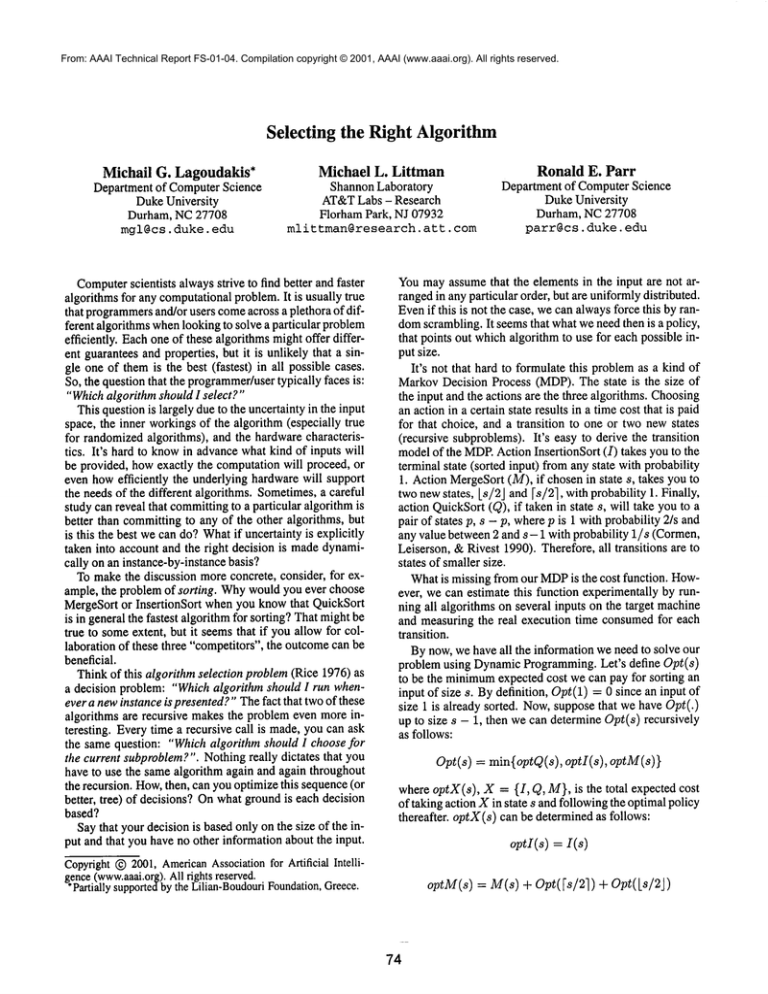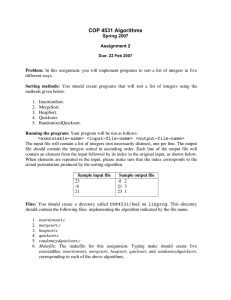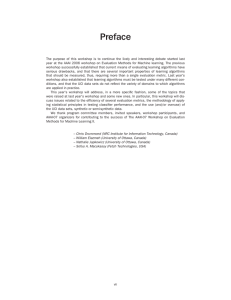
From: AAAI Technical Report FS-01-04. Compilation copyright © 2001, AAAI (www.aaai.org). All rights reserved.
Selecting the Right Algorithm
Michail G. Lagoudakis*
Department of ComputerScience
Duke University
Durham, NC 27708
mgl@cs, duke. edu
Michael L. Littman
Ronald E. Parr
Shannon Laboratory
AT&TLabs - Research
Florham Park, NJ 07932
mlit tman@research,att. com
Department of Computer Science
Duke University
Durham, NC 27708
parr@cs,duke. edu
Youmayassume that the elements in the input are not arranged in any particular order, but are uniformlydistributed.
Evenif this is not the case, wecan alwaysforce this by randomscrambling. It seemsthat what we need then is a policy,
that points out whichalgorithm to use for each possible input size.
It’s not that hard to formulate this problemas a kind of
MarkovDecision Process (MDP).The state is the size
the input and the actions are the three algorithms. Choosing
an action in a certain state results in a time cost that is paid
for that choice, and a transition to one or two new states
(recursive subproblems).It’s easy to derive the transition
modelof the MDP.Action InsertionSort (/) takes you to the
terminal state (sorted input) fromany state with probability
1. Action MergeSort(M), if chosenin state s, takes you
two new states,/s/2J and Is/2], with probability 1. Finally,
action QuickSort(Q), if taken in state s, will take youto
pair of states p, s - p, wherep is 1 with probability 2/s and
any value between2 and s- 1 with probability 1/s (Cormen,
Leiserson, &Rivest 1990). Therefore, all transitions are to
states of smallersize.
Whatis missing from our MDPis the cost function. However, we can estimate this function experimentally by running all algorithms on several inputs on the target machine
and measuring the real execution time consumedfor each
transition.
By now,we have all the information we need to solve our
problem using DynamicProgramming. Let’s define Opt(s)
to be the minimum
expected cost we can pay for sorting an
input of size s. By definition, Opt(l) = 0 since an input of
size 1 is already sorted. Now,suppose that we have Opt(.)
up to size s - 1, then we can determine Opt(s) recursively
as follows:
Computerscientists alwaysstrive to find better and faster
algorithmsfor any computationalproblem.It is usually true
that programmers
and/or users comeacross a plethora of different algorithms whenlooking to solve a particular problem
efficiently. Eachone of these algorithmsmight offer different guaranteesand properties, but it is unlikely that a single one of themis the best (fastest) in all possible cases.
So, the question that the programmer/user
typically faces is:
"Whichalgorithm should I select?"
This questionis largely due to the uncertainty in the input
space, the inner workingsof the algorithm (especially true
for randomizedalgorithms), and the hardwarecharacteristics. It’s hard to knowin advancewhat kind of inputs will
be provided, howexactly the computation will proceed, or
even howefficiently the underlying hardware will support
the needs of the different algorithms. Sometimes,a careful
study can reveal that committingto a particular algorithmis
better than committingto any of the other algorithms, but
is this the best we can do? Whatif uncertainty is explicitly
taken into account and the right decision is madedynamically on an instance-by-instance basis?
To makethe discussion more concrete, consider, for example, the problem of sorting. Whywould you ever choose
MergeSort or InsertionSort when you knowthat QuickSort
is in general the fastest algorithmfor sorting? That mightbe
true to someextent, but it seemsthat if you allow for collaboration of these three "competitors", the outcomecan be
beneficial.
Think of this algorithm selection problem(Rice 1976)
a decision problem: "Whichalgorithm should I run whenevera newinstance is presented?"The fact that two of these
algorithms are recursive makes the problem even more interesting. Every time a recursive call is made,you can ask
the same question: "Which algorithm should I choose for
the current subproblem?".Nothingreally dictates that you
have to use the same algorithm again and again throughout
the recursion. How,then, can you optimize this sequence(or
better, tree) of decisions? Onwhat groundis each decision
based?
Say that your decision is based only on the size of the input and that you have no other information about the input.
Opt(s) = min{optQ(s), optI(s),
optM
where optX(s), X = {I, Q, M}, is the total expected cost
of taking action X in state s and followingthe optimal policy
thereafter, optX (s) can be determinedas follows:
optX(s)=x(8)
Copyright© 2001, AmericanAssociationfor Artificial Intelligence(www.aaai.org).
All rights reserved.
*Partially supportedbythe Lilian-Boudouri
Foundation,Greece.
optM(s) = M(s) + Opt(Is~2]) + Opt([s/2J)
74
0~
O~
0.o4
2"
I O.OCl
J
Figure 1: Average Performance of Sorting Algorithms on
the Sun Spapc/Solapis Architecture
lS--1
+tQ(s)=Q(s)+ ;E (Opt(p)+Opt(s-p))
+}(Opt(l)
+opt(swhere X(s) is the immediate cost function we experimentally determined for each action X. Obviously, the optimal
action for state (size) s wouldbe the action that yields the
minimumOpt(s) in the equation above.
This algorithm was implementedand all calculations were
performedup to size 100, since it is knownthat this is the
critical area. Abovethat size QuickSortis definitely the optimal choice. The resulting optimal policies on two different
machinesape as follows:
Spare
Size
2 - 21
22 - 32
33- ...
(Solaris)
Algorithm
InsertionSort
MergcSort
QuickSort
Pentium
Size
2- 17
18 - 30
31- ...
(Linux)
Algorithm
InsertionSort
MergeSort
QuickSort
As expected, the resulting hybrid algorithm performs much
better than any of the individual three algorithms. Figure
1 demonstrates savings of 43%over QuickSort, 50%over
Merge, Son and 69%over InsertionSort for inputs of size
100. The graph represents the average running time of each
algorithm over 100 random instances (same for all algorithms)for sizes 1, 2 ..... 100.
Lookingat the running time curves of InsertionSort and
QuickSortand particularly at the point they cross each other
(~ 48), you might be tempted to create yet another algorithm with the following policy:
Size
2 - 48
49 -...
the algorithmics community,but as shownwith the example
abovea moreformal approachcan yield even better results.
There are someissues that arise in the context of recursive algorithm selection. Wecan assume randomdistribution for elementsin the original input, but is this maintained
for the subproblemsduring the recursion? Perhaps, subinstances becomemore and more sorted as we go, therefore
the cost function is not valid anymore.If this is true, given
that the distribution of the elementsis hiddenstate, the result
is a violation of the Markovproperty. Enhancingthe state
description with more information might reveal the hidden
information, but it will makethe derivation of a modelpractically impossible; a learning methodwill be necessary.
The resulting hybrid algorithm is somewhatfixed. What
if somechangein the underlying hardwareor a different set
of data results in a different cost function? Canwe recompute the optimal policy dynamically? That is, can we continually update the individual cost function to be closer to
reality, and solve the dynamicprogrammingproblem on the
fly? This might be possible to someextent using a function
approximatorto represent the cost functions. The cost function is knownto be linear for QuickSortand MergeSort,and
somewherebetweenlinear and quadratic in the average case
for InsertionSort. The approximatorshould be able to adapt
with only a few examplepoints. The use of such function approximators has been investigated in (Lagoudakis&Littman
2000) for representing the value function in a model-free
learning setting.
Wefocused on the problemof sorting in this paper. However, it is possible to extendthese ideas to several other domainsthat enjoy portfolios of algorithms and recursive algorithms in particular. Promisingresults havebeen obtained
on the problem of order statistic selection (Lagoudakis
Littman 2000) and on the problemof propositional satisfiability (Lagoudakis&Littman 2001).
This work demonstrates that learning and optimization
methodscan be effectively used to cope with uncertainty in
computation.It is plausible that, in the future, problemswill
be solved by adaptive systems that encapsulate several algorithms and improvetheir performanceusing past experience.
References
Cormen,T. H.; Leiserson, C. E.; and Rivest, R. L. 1990. Introduction to Algorithms. Cambridge,MA:The MITPress.
Lagoudakis, M. G., and Littman, M. L. 2000. Algorithm
selection using reinforcementlearning. In Langley, P., ed.,
Proceedings of the Seventeenth International Conference
on Machine Learning, 511-518. Morgan Kaufmann, San
Francisco, CA.
Lagoudakis, M. G., and Littman, M. L. 2001. Learning to
select branchingrules in the dpll procedurefor satisfiability. In Kautz, H., and Selman,B., eds., Electronic Notesin
Discrete Mathematics (ENDM),Vol. 9, LICS 2001 Workshop on Theoryand Applications of Satisfiability Testing
(SAT2001). Elsevier Science.
Rice, J.R. 1976. The algorithm selection problem. Advances in Computers15:65-118.
Algorithm
InsertionSort
QuickSort
The performance of this algorithm is shownwith a dashed
line and it is clearly not as goodas the policy derived using
the MDP.This is because interactions between the two algorithms are not taken into account (Lagoudakis &Littman
2000). Note also the discontinuity of the curve at the cutoff point. Such cut-off point algorithms are popular among
75







